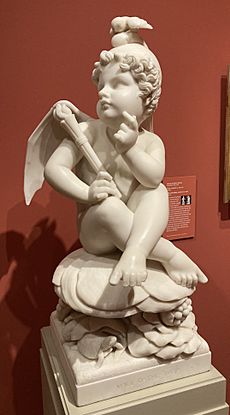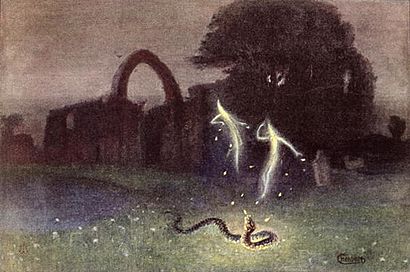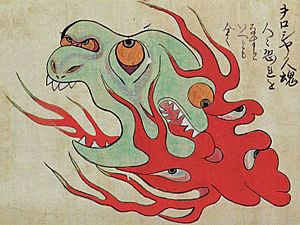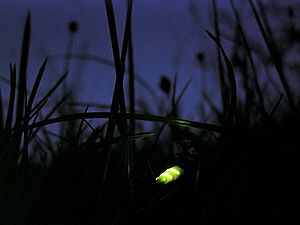Will-o'-the-wisp facts for kids
Have you ever heard of a mysterious light that dances in the dark, especially over swamps? This is often called a will-o'-the-wisp. People also know it as a jack-o'-lantern or a foolish flame (ignis fatuus in Latin). These lights are said to trick travelers at night, making them think it's a lamp or lantern.
In old stories, will-o'-the-wisps are often thought to be ghosts, fairies, or nature spirits. But today, scientists believe these lights are natural. They might be caused by gases from rotting plants and animals, like phosphine and methane, catching fire in the air.
Contents
What Does "Will-o'-the-Wisp" Mean?
The name "will-o'-the-wisp" comes from two parts. "Wisp" means a small bundle of sticks or paper, which people sometimes used as a torch. "Will" is a common name. So, it means "Will of the torch." The name "jack-o'-lantern" also used to mean a will-o'-the-wisp. In some places, people call them "spook-lights" or "ghost-lights."
The Latin name, ignis fatuus, means "foolish fire." This name was first used in Germany in the 1500s. It was a way to make the German name, Irrlicht (meaning "wandering light"), sound more scientific.
People in the past had many other names for these lights. If seen in graveyards, they were called "ghost candles."
Stories Behind the Lights
Many folk tales explain where will-o'-the-wisps come from. In Ireland, Scotland, England, and Wales, stories tell of people named Will or Jack who are stuck haunting marshes with a light because of something bad they did.
One story from England is about Will Smith, a bad blacksmith. He was given a second chance at heaven but lived a terrible life. So, he was doomed to wander the Earth. The Devil gave him a burning coal to keep warm. Will then used this coal to trick travelers into getting lost in the marshes.
An Irish tale tells of a man named Jack, who was very stingy. He tricked the Devil twice to avoid going to hell. Because he was so bad, he couldn't go to heaven either. So, when he died, he went to hell, but the Devil wouldn't let him in. The Devil gave him a burning ember from hell to light his way through the dark world of lost souls. Jack put the ember inside a carved turnip to make a lantern. This is where the idea of the jack-o'-lantern for Halloween comes from!
Will-o'-the-Wisp Around the World
Mysterious lights appear in stories and legends all over the globe.
Americas
In Mexico, people say these lights are witches who have changed their shape. Other stories say they show where gold or hidden treasures are buried. These are called luces del dinero (money lights) or luces del tesoro (treasure lights).
The Bridgewater Triangle in Massachusetts is known for stories of ghostly light orbs. People still report seeing these lights there today.
In Louisiana, the fifollet (or feu-follet) is a soul sent back from the dead. It is said to play harmless tricks on people.
Brazil has the Boi-tatá, which means "fiery serpent." This giant snake is said to have survived a great flood. At night, its fiery eyes help it see everything as it hunts.
In Argentina and Uruguay, the lights are called luz mala (evil light). This is a very feared myth in rural areas. It looks like a very bright ball of light floating just above the ground.
In Colombia, la Bolefuego is the ghost of a mean grandmother. Her spirit was condemned to wander the world surrounded by flames. In Trinidad and Tobago, a soucouyant is a "fireball witch" that takes the form of a flame at night.
Asia
In India, the Aleya is a strange light seen over marshes, especially by fishermen. People believe these lights are the ghosts of fishermen who died. They might confuse fishermen or sometimes help them avoid danger. Another light, Chir batti, dances in the Rann of Kutch desert.
Japanese folklore describes similar lights like Hitodama (human soul) and Kitsune-bi (fox-fire). These are often linked to graveyards or mythical fox spirits called Kitsune.
In Korea, the lights are called dokkebi bul (goblin fire). They are seen in rice fields, old trees, or mountains. People thought they were mischievous goblins that confused travelers and made them fall into pits.
The earliest Chinese writings mention a character for a will-o'-the-wisp, showing a person surrounded by glowing dots. A Chinese scholar named Shen Kuo wrote about a huge, bright pearl seen in a marsh in the 1000s. It was so bright it lit up the countryside!
Europe
In Europe, people often believed these lights were the spirits of children who died before being baptized. They were thought to be stuck between heaven and hell.
In Sweden, a will-o'-the-wisp is seen as the soul of an unbaptized person trying to lead travelers to water so they can be baptized.
Many countries, like Denmark, Finland, Sweden, and Ireland, believed that a will-o'-the-wisp marked the spot of hidden treasure. You could only get the treasure when the light was there. Sometimes, you needed magic tricks to find it. In Finland, these lights are called Aarnivalkea, and they are said to mark places where fairy gold is buried.
Britain

In Wales, people say the light is "fairy fire" held by a púca, a small goblin-like fairy. The púca mischievously leads travelers off their path at night. As the traveler follows, the fire goes out, leaving them lost. One Welsh story tells of a peasant following a light held by a "dusky little figure." The figure led him to the edge of a huge cliff, then jumped across, laughed, and blew out the light, leaving the peasant stranded.
However, not all stories say will-o'-the-wisps are dangerous. Some tales say they are guardians of treasure, like the Irish leprechaun, leading brave people to riches. Other stories say they might guide lost travelers out of the woods, depending on how they are treated.
In Devon and Cornwall, the "pixy-light" also leads travelers into bogs. In Guernsey, the light is called the faeu boulanger (rolling fire) and is believed to be a lost soul. To stop it, you can turn your coat inside out or stick a knife into the ground.
In the Scottish Highlands, the will-o'-the-wisp was called the Spunkie. It might look like a boy carrying a torch or just a light that always moved away. It would lead travelers to danger and was even blamed for shipwrecks. Other Scottish tales say these lights are signs of death or ghosts of people who have died.
Oceania
In Australia, the Min Min light is seen in the outback after dark. Many sightings happen in the Channel Country. Stories about these lights existed in Aboriginal myths long before Europeans arrived. People say the lights sometimes follow or approach people. They might disappear if shot at, only to reappear later.
Scientific Explanations
Scientists have tried to explain will-o'-the-wisp phenomena for a long time.
They suggest that the lights are caused by gases like phosphine and methane. These gases are made when plants and animals decay in wet, marshy places. Phosphine can catch fire on its own when it touches air. This small flame could then light the more common methane gas, creating a flickering light. When phosphine burns, it also creates a substance that can form a "viscous moisture" (sticky wetness), which some people reported seeing with the lights.
The idea that natural gases cause these lights goes back to the 1500s. In 1776, Alessandro Volta suggested that lightning or other electrical events could make marsh gas light up.
Some people doubted the gas theory. They wondered why the lights didn't feel warm or why they moved away when approached. They also questioned how a burning gas could look like a ball of fire and move in such strange ways without being connected to the ground.
However, in 1832, Major Louis Blesson did experiments in marshes. He found that the lights did move away when he approached, likely because his movement stirred the air and dispersed the gases. He managed to light paper with the flames by shielding his breath. He also saw that the flames changed color and heat in different marshes.
Another idea is that will-o'-the-wisps are "cold flames." These are faint glows that happen when certain chemicals are heated just below their burning point. Cold flames are usually bluish and produce very little heat. Many of the chemicals that create cold flames are also made when organic matter decays.
In 2008, some Italian chemists tried to recreate the lights in a lab. They made a faint, cool, greenish light by mixing phosphine with air. They noted that in low light, the human eye might not notice the green color. They also found that by changing the gas amounts, they could make the smoke and smell disappear.
Some scientists also think that some will-o'-the-wisps might be caused by geology. When rocks with minerals like quartz are under stress from Earth's movements, they can create electricity. This electricity might travel up to the surface through water vapor and appear as lights. This could explain why some lights seem electrical or even intelligent.

Another possibility is bioluminescence. This is light made by living things. For example, some fungi, like the honey fungus, glow in the dark. This "foxfire" could be mistaken for a will-o'-the-wisp. Even the white feathers of Barn owls might reflect moonlight enough to look like a moving light.
Today, people report seeing will-o'-the-wisps much less often. This is probably because many swamps and marshlands have been drained and turned into farmlands.
More Names for Will-o'-the-Wisp
Americas
|
Asia
Europe
Oceania |
See also
 In Spanish: Fuego fatuo para niños
In Spanish: Fuego fatuo para niños
- Chir Batti
- Feuermann (ghost)
- Foo fighter
- Hessdalen Lights
- Kitsunebi
- Lantern man
- Lidérc
- Mãe-do-Ouro
- Omphalotus olearius
- Santelmo
- Simonside Dwarfs
- St. Elmo's fire
- Yan-gant-y-tan




